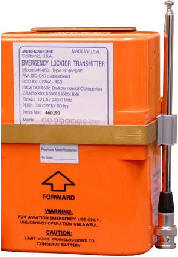|
|||||||||||
|
|
|
|||
|
By |
||||
 |
June 24, 2010 -
Distress radio beacons, also known as emergency beacons, ELT or
EPIRB, are tracking transmitters which aid in the detection and location
of boats, aircraft, and people in distress.
Most aircraft
today are equipped with an ELT operating on a frequency of
406.0-406.1 MHz that
interface with
Cospas-Sarsat, the international satellite system for search and rescue
(SAR). When activated, such beacons send out a distress signal that,
when detected by non-geostationary satellites (A non-geostationary
satellite is one where its position relative to the Earth is not fixed),
can be located by trilateration.
|
|||
| ELT On 121.5 MHz | ||||
|
|
||||
|
The
Federal Communications Commission (FCC) which licenses this frequency
has concluded that ?there
is no dispute that 406.0-406.1 MHz ELTs are more accurate and reliable
than 121.5 MHz ELTs, and minimize false alerts.?
The 406 MHz ELT
transmit a digital signals, the ELT can be uniquely identified almost
instantly (via GEOSAR), and furthermore, a GPS or GLONASS position can
be encoded into the signal, which provides instantaneous identification
of the registered user and its location. Frequently, by using the
initial position provided via the satellite system, SAR aircraft and
ground search parties can home in on the distress signals from the ELT
and come to the aid of the aircraft.
?We believe that if 121.5 MHz ELTs are no longer available, aircraft
owners and operators will migrate to 406.0-406.1 MHz ELTs, and the
advantages of 406.0-406.1 MHz ELTs will provide safety benefits for
search and rescue teams as well as aircraft pilots, crew and passengers,
while also preserving search and rescue resources for real emergencies.
Were we to permit continued marketing and use of 121.5 MHz ELTS, on the
other hand, it would engender the risk that aircraft owners and
operators would mistakenly rely on those ELTs for the relay of distress
alerts?. |
||||


